 
BOWLES COMPACTION FRONT LOADERS
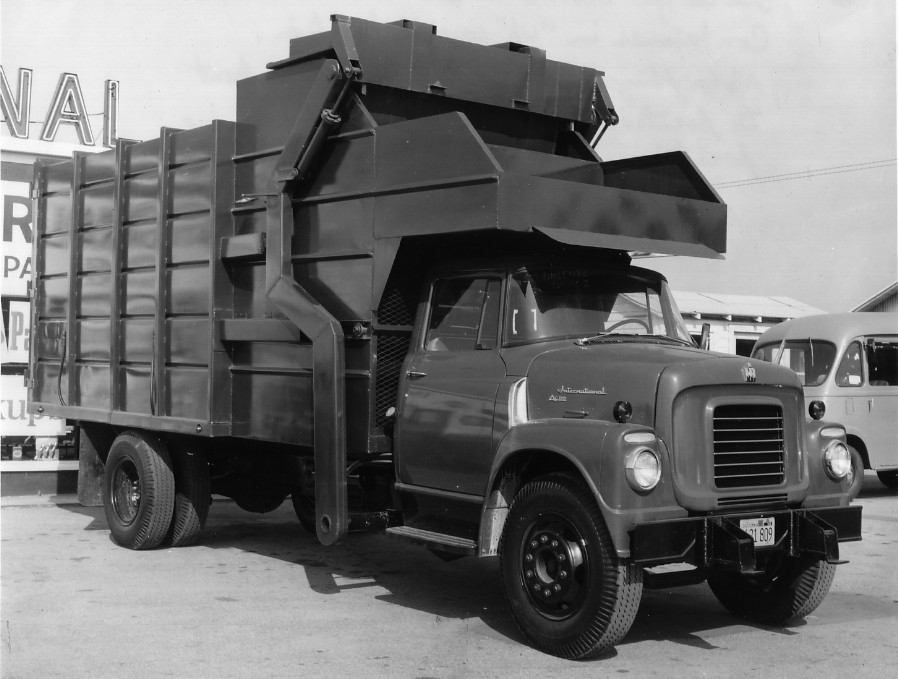
1956 Bowles 32-cubic yard front-loading packer on International AC 180 chassis
In 1956, Bowles introduced fully reinforced, enclosed bodies of large capacities, and added a compaction panel that traversed the loading hopper area in the front of the body. With a stroke of 68 inches, the panel cleared the hopper area as needed, making way for successive loads, and also compacted the refuse as the body filled. These new Partial-Packers (today known as Half-Packs) were another Bowles front loader first, carrying maximum legal payloads by adding compaction with a minimum of excess weight.
Additionally, the practice of custom-building the lift arms to clear the wheel wells of the truck was introduced, which allowed for better steering control. Many of these front loaders were used in residential collection, where the driver would be required to move from stop to stop with lift arms lowered and a container attached. Easy maneuverability was essential, especially as the bodies were increasing in size. The problem of rear view mirrors, which were directly in the path of the moving lift arms, would require a mechanical solution in the form of automatic retraction systems, synchronized to the movement of the arms.
The Bowles Front Loader with "Pull Back" Partial Packer
This was the first packer system used by Bowles beginning in 1956. Over time, many variations in body, lift and packer styles would be used, but the "Pull Back" system was by far the most popular in the early years, and is unique to Bowles. Here are the basic components:
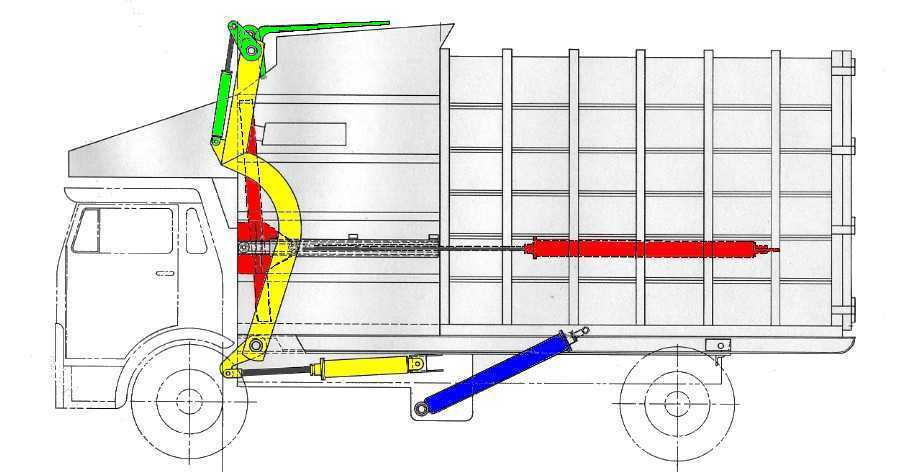
Lift arms (yellow highlights) pivot on torque tube at lower front of body structure. Arms are actuated by two double-acting hydraulic cylinders, mounted under the body. Fork superstructure (green highlights) is pivotally attached between ends of lift arms, and rotated by two double-acting cylinders mounted near the ends of each lift arm. Packer blade (red highlights) is carried on rollers; two each guided by tracks in the left and right hopper walls, and two in contact with the hopper floor. Twin double-acting cylinders (mounted inside main body) pull blade rearward to clear hopper and pack. Both the track slots and cylinder rods were recessed within the hopper walls, and thus somewhat protected from the incoming refuse. Note how very little 'dead space' exists ahead of the packer blade, since there are no packing cylinders located there. Result: more usable hopper area. For unloading, two cylinders (blue highlights) are used to hoist the body and discharge the load by gravity. All hydraulic cylinders were manufactured by Bowles in Sun Valley.
|
Bowles was unique in their packer design, and to this day remains the only company to utilize the Pull Type cylinder arrangement, rather than the now-conventional push type, which has its cylinders mounted ahead of the packer blade. The pull type had several advantages; it could travel all the way to the front of the body, completely eliminating the dead space that a push type would need to house its packing cylinders. It also saved from having to replace the hopper floor by minimizing the pressure being applied there. It was a lot cheaper to replace cylinders (or occasionally a packer blade) than to replace the floor.
Many of Bowles' competitors, particularly Dempster and Western, would favor the Full-Pack system, where the packer blade travelled the entire length of the body to crush each batch of refuse. Full-Pack models could carry denser payloads, but also came with a weight penalty, since the body shell had to be reinforced to withstand high, localized pressures throughout its length. Full-packs of any great length also needed a telescopic packing cylinder, which was heavier, more expensive and required a greater oil supply.
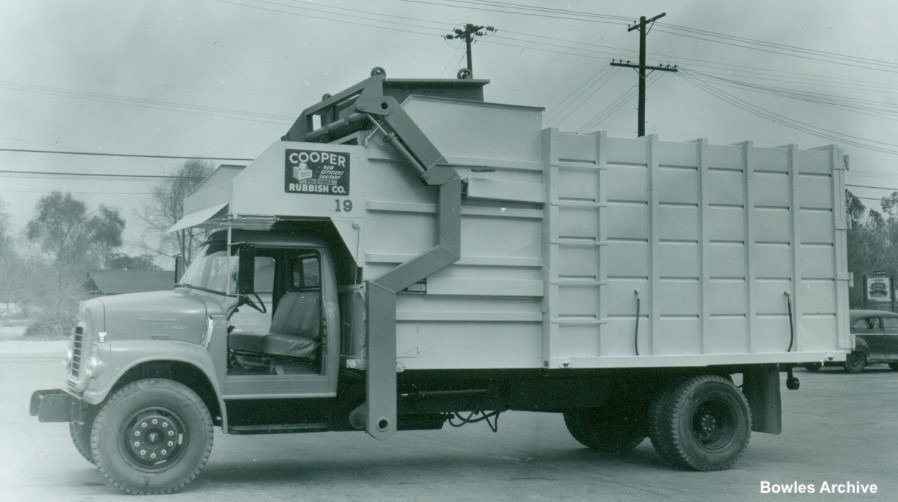
Early Bowles with cab doors removed for crew convenience, which also prevented potential damage from lift arm contact
The Partial Pack method may have been born out of economy, but is now favored by much of the industry. One reason is speed, since the conventional single stage packing rams react faster, and the blade travels only a short distance. The total cycle time on the Bowles Pull-Back packer was a mere 30 seconds. The other reason is weight; because Partial Packers don't really begin compressing the load until the body is filled, the stresses are spread more uniformly throughout the entire structure. Body bracing need not be as heavy, resulting in less dead weight and more legal payload. Bowles would also offer a wide variety of models and styles, including their own Full-Pack bodies and Push-Type Partial Packers. However, in the early years the firm would be most commonly associated with the pull-back method.
The Econo-O-Packer System
Below is an International cabover with a Bowles body, owned by the City of Glendale. This image was used in what is believed to be the first Bowles advertisement targeting a national audience for their product, run by distributor J.E. McDonald. The ad was run in American City Magazine in November of 1957. Bowles equipment of this period is frequently advertised as the Econo-O-Packer System, and the small company began to find new customers across the western states.
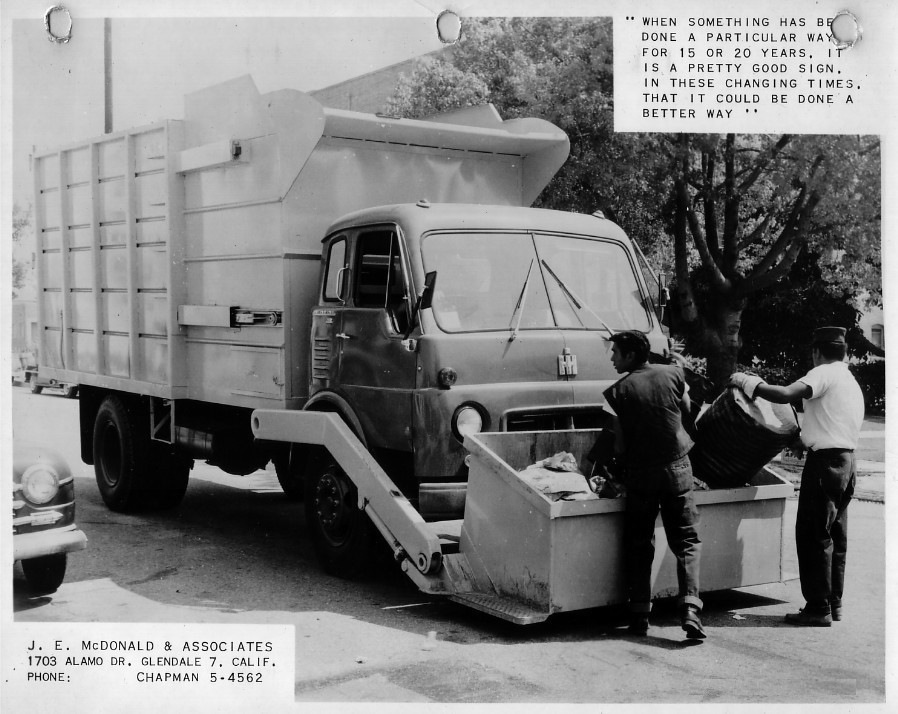
Comparing this truck to the previously shown photos, we can see the variety of different features found on early Bowles bodies. Some major changes have been made to the lift arms since the truck is a cabover engine type. The torque tube that carries the lift arms is here mounted above the frame rails, minimizing interference by the arms with the front wheels while in the lowered position. Mounting them below the frame (as on conventional cabs) would have impeded steering due to the front axle location. Later versions of cabover lift arms would have a pronounced curve, allowing them to completely clear the wheel wells. This version lacks the salvage rack over the cab, which would have interfered with the shorter lift arms. A simple deflector shield was often added in place of the salvage rack on cabover models. It also has a solid front body panel, instead of the open front or screen mesh seen on many early versions.
Up front is a detachable hand-loading bucket for residential refuse collection. The bucket has steps for the loaders to ride on between stops. The clear advantage here over rear loaders was visibility, since the driver has his helpers in plain sight at all times. Unfortunately, the rearview mirrors have to be folded in during the loading process to prevent being sheared off by the lift arms
|
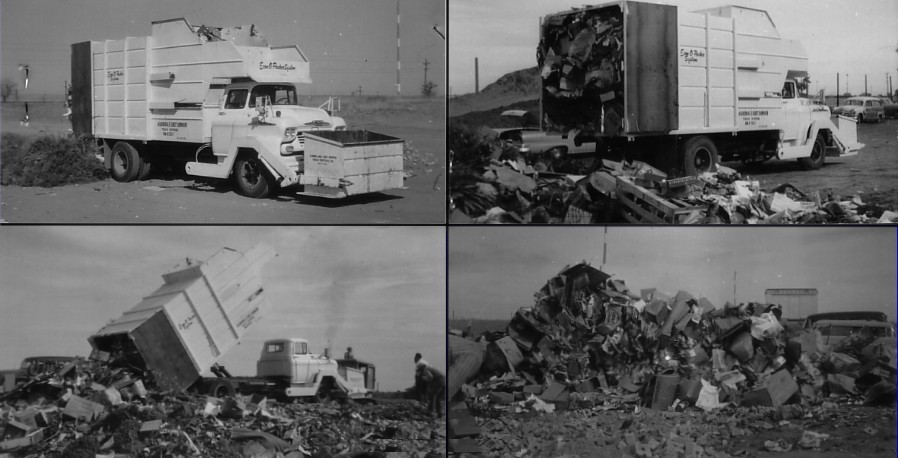
Unloading was the same as on the old open bodied trucks. Rear doors are unlocked and swung clear, and a twin-cylinder hoist raises the body to a high angle. The packing panel, though only able to travel a few feet, does perform partial load ejection, enough to move weight away from the highest point in the raised body. The portion of the body shell aft of the hopper area was constructed with a front-to-rear taper, which helped the compacted load to slide out easier when tilted. The conventional cab truck, with its engine far forward in the frame, offered a better counter-balance to the raised body than comparable cabover models.



1/17/10
© 2010
All Rights Reserved
Logos shown are the trademarks of respective manufacturers
Photos from factory brochures/trade advertisements except as noted
|
| |